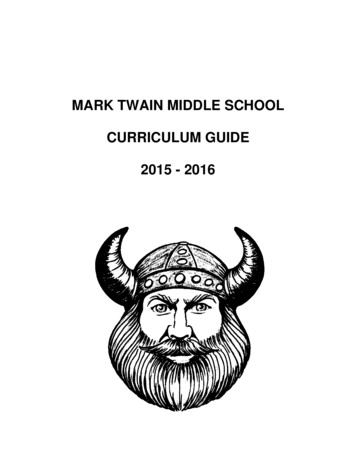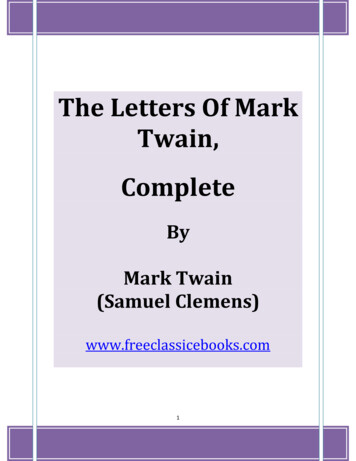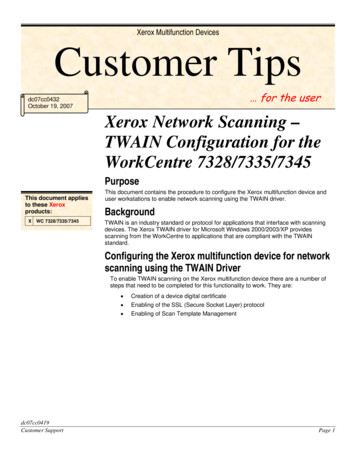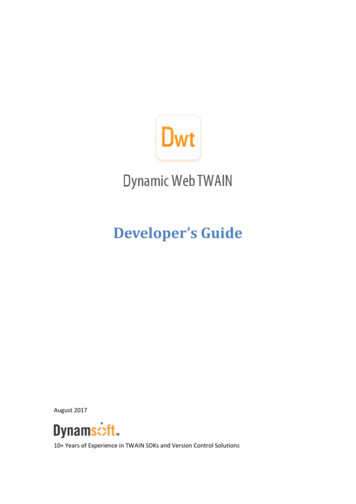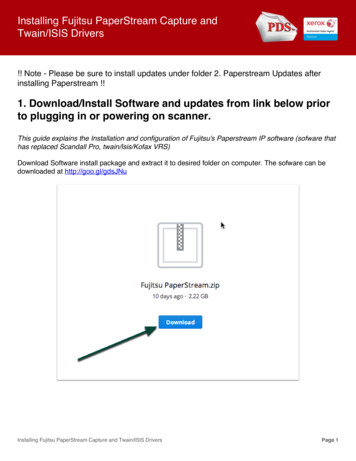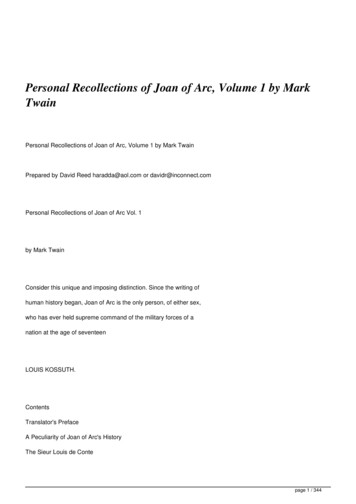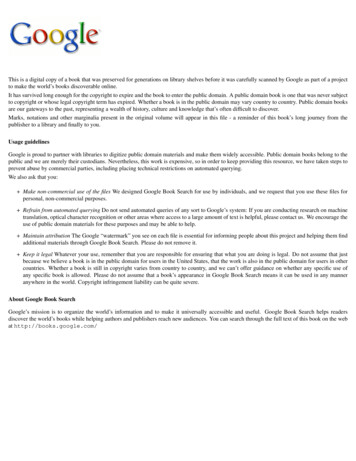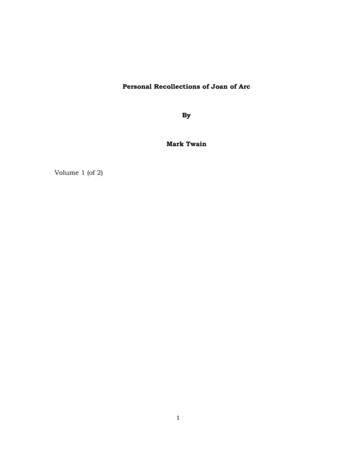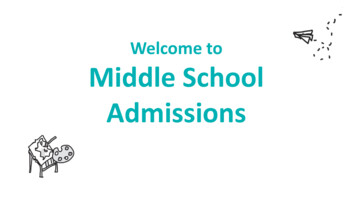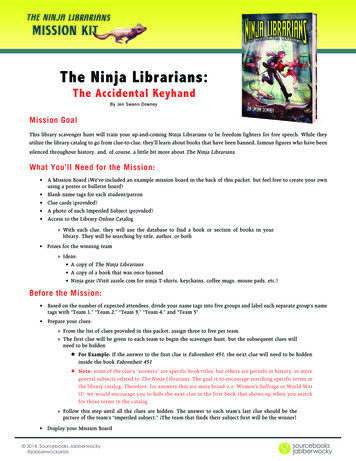
Transcription
Mark Twain Boyhood Home & MuseumLesson or Unit Plan for “The Story of the Bad Boy” by Mark Twain (1865)“The Story of the Good Little Boy” by Mark Twain (1875)Created by: Sherry ToddSchool: Moberly Area Community CollegeCity, State: Kirksville, MOMark Twain Teachers’ Workshop, July 14, 2017Hannibal, MissouriBad BoyUNIT PLAN for“The Story of the Bad Little Boy” by Mark Twain (1865)Concept or Topic:Literary AnalysisSuggested Grade Level(s)/Course:First year at Community CollegeSubject:Literature/WritingSuggested Time Frame:85-minute class periods, 2 times eachweek, 3 weeks in unitObjective(s): The First Year College student will write a Literary Analysis usingcorrect MLA format and score at least 75 out of 100 on the “Writing Rubric.” (Attached)Common Core State Standards:Assessments (at least two): Literary Analysis Essay, 2 quizzes, group grade on MLACitation ActivityVocabulary (Tiers 2 & 3): irony, logos, pathos, ethos, enthymemeSubject Area Integration: History (Historical Criticism), SociologyBackground Information Required for Lesson: Students have been taught how towrite a clear thesis statement and support the statement logically.Materials: Class handouts including “The Story of an Hour” by Kate Chopin (1894),“The Story of The Bad Boy” by Mark TwainTechnology: White board, computers, printer, Audiovisual equipmentLesson Sequence:DAY 1Hook/Intro: Theatrically drag in a suitcase filled with stacks of old books along with abag of current best sellers. Set all on the front desk in a struggling manner. Ask thequestion” What is Literature and why do we care?” (5 minutes)1
UNIT PLAN for“The Story of the Bad Little Boy” by Mark Twain (1865)Teaching of the Concept(s):1. Lecture on Literature and the importance of story (8 minutes)2. Introduce Literary Analysis (2 minutes)3. Review Bloom’s Taxonomy, Analysis (taking apart and looking at the parts) (2minutes)4. Review and write on white board the parts of fiction (plot, characters, setting,narrator, symbols, point of view, theme, tone) (8 minutes)5. Handout “The Story of an Hour” Kate Chopin (1894) (1 minute)7. Read it aloud to class (10 minutes)Suggested Questions:Why is close reading important?What is the difference between fiction and nonfiction?What can we learn from fiction?What are the parts of fiction?What is irony?Where do you see irony in the story?Learning Activity:Analyze “The Story of an Hour” (20 minutes)Hand out a student essay analyzing “The Story of an Hour” (1 minute)Read the student essay to the class (4 minutes)Discuss and define “Irony” (5 minutes)Group work finding specific places in the text that show irony (15 minutes)Review/Closure:Reiterate parts of fiction (5 minutes)Review importance of close reading (5 minutes)Remind students of their educational journey and the value of critical thinking (5minutes)Homework:Read handout “The Story of the Bad Boy” to identify literature elementsAssign close reading of the text with the expectation of a reading quizStrategies for Exceptional Students:Preteach vocabulary/conceptsDirect instructionModeling/ examplesSuggested Follow-Up Activities:“The Importance of Storytelling” Emmanuel Dzotsi TEDxOhioStateUniversity2
UNIT PLAN for“The Story of the Bad Little Boy” by Mark Twain (1865)DAY 2Hook:Play YouTube video of “Bad Boys, Bad Boys” by Bob Marley (4 minutes)What does this make you think of? (3-5 minutes)Teaching of the Concept:1. Reading quiz over “The Story of the Bad Boy” (10 minutes)2. Readers response to the story (10 minutes)3. Short in-class writing about the story (10 minutes)4. Discuss story plot, setting, characters, setting, theme, narrator, symbols, point ofview and tone (20 minutes)Learning Activity:Group work “Found Poem” Activity to reiterate the story and differing views of story(20 minutes)Suggested Questions:Did you like the story? Why or why not?What personal connection can you make to the story?Do you think the time period Twain wrote this story impacted the writing? How?How might the story be different if it were a contemporary writing?Review/Closure:Review the importance of close reading and its value when analyzing literature.Review the parts of fiction.Homework:Assign Literary Analysis Essay:Prompt:For this essay you will be analyzing “The Story of the Bad Boy” written by Mark Twainand published in 1865. You will analyze this story in an argumentative essay.Ten steps to Writing this Essay1. Read the story with an eye toward a good topic.2. Choose a topic—about an aspect of the story’s form or content. Note that a topic isa general subject—you will need to turn that into a thesis later on in this process. Turnthe topic into a question. For example, if your topic is characterization in “The Bet,”then turn the topic into a question. “How does Chekhov portray the lawyer?” Once youhave turned the topic into a question, the rest of the steps will become easier.3. Reread the story with your topic as a filter. In this way, you will be isolating thepassages from the story that relate to your topic. In other words, find the passagesthat help you answer the question.4. Mark passages in the story that relate to your topic (and it would be helpful to,afterward, type these into a word processing file).5. Analyze these passages and develop a thesis from them. The thesis would be yourarguable proposition about your topic.3
UNIT PLAN for“The Story of the Bad Little Boy” by Mark Twain (1865)6 Organize these passages in order to most effectively support your thesis. Don’t feelyou need to follow the same order that they appear in the story.7. Properly introduce, present, and interpret each passage.8. Link your passages with proper transitions. Imagine that each paragraph would beanalyzing only one or two passages.9. Revise.10. Be sure to include a correct MLA work cited page.Also note that this essay is not a plot summary—you do not spend the entire essaytelling what happens in the story—you analyze it.The first paragraph must include—the author of the story (this means that all yourtextual citations will only need a page # in parentheses), the title of the story (inquotation marks), and a one or two sentence synopsis of the story, and your thesis.Workshop in one weekDue in two weeksDAY 3Hook/ Intro: Unveil new portrait of Mark Twain.Ask students to identify who is portrayed in the painting.Ask students to write five questions they would like to ask him. (10 minutes)Teaching of the Concept(s):1. Show film from Films on Demand entitled Mark Twain: His Amazing Adventures (46minutes).2. Discuss the film and how it answered students’ questions.3. Assist students in making possible connections between Twain’s life and “The Storyof the Bad Little Boy.”Suggested Questions:What questions did you have about Mark Twain?What did you already know about him?How many of you have visited his home in Hannibal?What new information did you gain from watching the film?How do you think Twain’s life and work was impacted by his growing up years inMissouri?If you had questions that were not answered by the film, where might you find thatinformation (besides Google)?Learning Activity:Class DiscussionReview/Closure:As you are writing your Literary Analysis, you might think about Mark Twain as thewriter and how his life may have impacted this story. Be sure to support any claimsyou make with solid evidence and cite your sources.Remember we will be Workshopping your Literary Analysis Essay the next time wemeet in class. Bring three copies of your essay to class and come prepared to reviewthree of your peer’s essays.4
UNIT PLAN for“The Story of the Bad Little Boy” by Mark Twain (1865)Homework:Complete your essay and bring three typed copies to the next class meeting.Strategies for Exceptional Students:Use group work for brainstorming questions about Mark Twain.Give personal examples of questions an instructor would like to ask Twain.Suggested Follow-Up Activities:Field Trip to Hannibal to visit museums, cave, lighthouse and ride riverboatView Ken Burn’s 2001 film Mark TwainUse additional questions offered on Films on Demand- Mark Twain: His AmazingAdventuresDAY 4Hook/ Intro:Today we are going to work shop essaysTeaching of the Concept(s):1. Each student gets three workshop worksheets and three different peer essays.Each peer review is worth up to 10 points. Be sure to be thoughtful in your responsesand help your peers improve their essays.Suggested Questions:Workshop Sheet:Learning Activity:Students work shop three peer essays using the attached workshop sheetReview/Closure:When you have completed all three of your own essays from your peers, carefullyread their suggestions. This is your essay and you make the final decision of whatshould be in it. But remember you want your readers to easily understand yourthoughts, so regard the suggestions seriously.Homework:Before next class, go into Purdue’s OWL (Online Writing Lab) and review correct MLAformat as that is what we will be working on next meeting.Strategies for Exceptional Students:Model using Workshop Sheet with the students using visual technology to project theworksheet and the essay on the screenSuggested Follow-Up Activities:5
OWL information on revising and MLA formatDAY 5Hook/ Intro:Come into class wearing casual gardening clothing. Ask class what is strange aboutmy appearance and why are they surprised. Talk about the importance of appearingappropriate in order to be seen as credible.Teaching of the Concept(s):1. Show Rhetorical Triangle (Ethos/ Pathos/ Logos) (5 minutes)2. Lecture on rhetorical theory and make connection with using correct format inacademia. (35 minutes)Suggested Questions:Why is credibility important?Can you think of everyday examples of the importance of credibility? (10 minutes)Learning Activity:Pass out a mixed selection of books, academic journal articles, and newspapers toeach group of threeAssign group the task of typing a correct MLA Work Cited page for their sources. It isdue at the end of class. (30 minutes)Review/Closure:Remember your Literary Analysis is due at the beginning of the next class. It mustinclude a correct MLA Work Cited page if you want full credit.Homework:Complete your essay and bring it with a correct MLA Work Cited page and the threeworkshopped copies to the next class meeting.Strategies for Exceptional Students:Using classroom camera and screen show them how to write a proper MLA WorkCited page.Ask their thoughts on order of entries and have them explain their reasoning.Suggested Follow-Up Activities:Look at several examples of MLA Work Cited from Academic journals.6
Literary Analysis Essay WorkshopName of EssayWorkshopped by1. Does the essay conform to the assignment?2. Does the first paragraph include the following:Author of the storyTitle of the storyOne or two sentence summary of the storyOnce sentence thesis statement3. Underline the thesis statement on the essay.4. Circle all the quotations.5. If any of the quotations are not properly documented in the essay, place a large X atthe end of those sentences.6. Below, give three examples of the writer using a quotation from the literary work toprovide evidence for his or her ideas.7. Does the writer integrate quotations smoothly into his or her sentences? Suggest anyhelp you can on the essay.8. Using the thesis statement as the main idea, briefly outline the essay.7
GRADING RUBRIC CREATIVE NONFICTION ESSAYAThesis/Development/Unity(Logos)40ptsEasily identifiable thesis that isoriginal and plausible. Clearlydeveloped beginning, middle,and end. All the language in theessay support and extends thethesis.Vivid Language20 ptsUses simile, metaphor,and personification todevelop and extendthesis. Uses moreconcrete language thanabstract. Uses morespecific language thangeneral.Uses figurative languagesuccessfully, but notwith the same freshnessas the “A” essay.Primarily uses concreteand specific language.Tone andLanguage(Pathos)20 ptsExpresses ideasfreshly. Clear writerposition andpersonality. Ideasseem feasible andimportant.Mechanically Correct(Ethos)20 ptsCorrect grammar;correct spelling; correctpunctuation; correctformat includingparenthetical remarksand an “AnnotatedWorks Cited” page.Lacks thedistinctive andconsistent voice ofthe “A” essay.Infrequent and isolatederrors such as commause, spelling, and verbusage. No pattern oferror. Correct formatincluding parentheticalremarks and an“Annotated WorksCited” page.Relatively few errors,but of a serious naturesuch as comma splice,run-ons, fragments,and agreement. Nopattern of error.Largely correct format,however, there may besome isolatedformatting errors.A significant number oferrors of the type listedabove. Patterns oferror. Formattingerrors resulting inunintentionalplagiarism.Serious and persistenterrors of the type listedabove. Unintentionalor intentionalplagiarism.BAdequate thesis, but notparticularly original. All languagerelates to thesis but does notextend it. Evident beginning,middle, and end.CThesis is not fully supported.Significant amount of unrelatedlanguage. Parts of structureclear, but parts unclear.Some effect at figurativelanguage but at timescliché. More generalthan specific. Moreabstract than concrete.Uneven voice.Writer’s positionconfused or notcompelling.DWeak of unidentifiable thesis.Little clear development.Language not related to thesis.Figurative languagescarce. General andabstract. More tellingthan showing.Tone voiceless anddisembodied.FNo thesis.No real effort at vividlanguage.Tone voiceless anddisembodied.8
9
For this essay you will be analyzing "The Story of the Bad Boy" written by Mark Twain and published in 1865. You will analyze this story in an argumentative essay. Ten steps to Writing this Essay 1. Read the story with an eye toward a good topic. 2. Choose a topic—about an aspect of the story's form or content.
